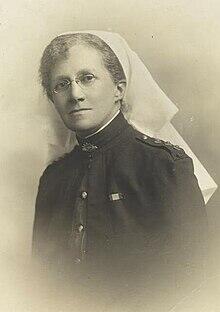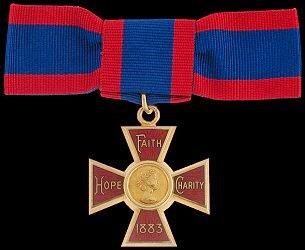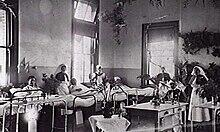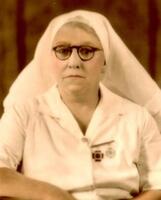
South Australian Medical Heritage Society Inc
Website for the Virtual Museum
Home
Coming meetings
Past meetings
About the Society
Main Galleries
Medicine
Surgery
Anaesthesia
X-rays
Hospitals,other
organisations
Individuals of
note
Small Galleries
Ethnic medicine
- Aboriginal
- Chinese
- Mediterran
Matron Ethel Sarah Davidson, CBE, RRC, MID [1872-1939]
ACKNOWLEDGEMENTS
We are most grateful to Christine Davidson, on behalf of the Yesteryear Group of the Oaklands VIEW club, for allowing us to present this article.
Ethel Sarah Davidson was born in 1872, in Tenderton (Woodville South), Adelaide to Scottish born Master Mariner William Davidson and William's second wife, Elizabeth Jane Green. She was orphaned at the age of five years when her father's Brigantine ship, the Emily Smith, was wrecked on Kangaroo Island in May 1877. Ethel was not on the ship but her parents, 2 younger brothers and her baby sister were on-board, and they all drowned. Afterwards Ethel was raised by her Adelaide based three grown half-brothers and three half-sisters from her father's first marriage.
Little is known of her early education, but she trained for three years as a nurse at the Royal Adelaide Hospital before becoming a district nurse in Prospect. Ethel joined the Central Board of Health and nursed privately.i She joined the Australian Army Nursing Service (ANNS) as a sister and reserve member in 1904.
On 26 September 1914 Ethel, aged 41 years, enlisted in the Australian Imperial Force as a sister and left her job as a district nurse in Prospect. She embarked on the HMAT A9 Shropshire with the first contingent for Egypt. When war began Davidson was one of the first three nurses from South Australia to leave for Egypt.ii
A post card sent to her niece on 5th December 1914 describes Egypt - "You will see by this we have landed at Egypt… don't expect we will stay here long, only while our troops are here. We are very lucky to be first here."iii Ethel was stationed in Egypt for one year and eight months.

On arrival in Egypt, she went to the Convalescent Depot in the Mena Camp near the pyramids where she witnessed harrowing scenes while treating soldiers with terrible injuries and debilitating diseases. Etheliv was Matron of the Convalescent Depot from August 1915 until January 1916. Later in 1916 she became temporary matron in the 3rd Australian Auxiliary Hospital (AAH) in Cairo. She was Mentioned in Despatches for her service and awarded the Royal Red Cross 2nd Class.

On 24 June she relinquished her position as Temporary Matron and embarked for London. Ethel spent six months with a rank of Head Sister in the medical section of the AIF headquarters. This was followed by a short time at the 2nd AAH in Southall. On 28 February 1917 Ethel moved to France to the Australian General Hospital in Wimereux to tend to those fighting on the Western Front.
In March she was transferred, as acting matron, to the 2nd Australian Casualty Clearing Station at Trois Arbres, near Steenwerckv where bombing was frequent with nurses carrying a constant and heavy workload.
She became temporary matron of the 38th British Stationary Hospital in Genoa in January 1918. Here Davidson was Mentioned in Despatches and awarded the Royal Red Cross 1st Class for her devotion and service.vi It was also here that she heard of the war ending. On discharge her rank was recorded as Matron.
She was awarded the Commander of the British Empire Award (CBE) in 1919vii for her hard work and efforts during wartime.
Ethel served Australia for the entirety of WW1 and remained connected to her patients long after the end of the fighting.
Ethel returned from the war in December 1919 to work at Keswick Military Hospital.viii She became Matron of the 4th Military District. When the Hospital came under the auspices of the Repatriation Commission Ethel continued as Matron until she reached retirement age in 1933.

"A grateful nation provided these military nurses with its highest compliment – it regarded them as similar to soldiers. Nurses who had served abroad could march on Anzac Day with the soldiers."ix
"The Returned Services League and other similar organisations also welcomed army nurses as both honorary and full members, although nurses also developed their own Returned Nurses' Associations."x Ethel was President of the Returned Nurses Association of South Australia from 1922 to 1926.xi She was active in the Nurses' Sub-Branch of the RSL and elected to its committee.xii In 1929 Ethel was appointed to the Nurses' Registration Board.xiii
In April 1939, the Adelaide News reported on page one "Her death, almost on the eve of ANZAC Day, has cast a gloom over Keswick Hospital. She will be mourned by large numbers of patients and hundreds of returned soldiers."xiv Ethel Sarah Davidson will be forever remembered in history and our hearts for her dedication and service to Australia.
Ethel never married. She is buried in the Australian Imperial Force (AIF) Cemetery, West Terrace, Adelaide. She is part of the Trailblazing Women Interpretive Trail at the cemetery – LO Path 1 AN Plot 16E.
References
- The Australian Women's Register 2018
- The Register, Tuesday 24 November 1914, page 6
- Helen Heggie, great niece 2018, https://vwma.org.au/explore/people/202770
- Photo https://en.wikipedia.org/wiki/Ethel_Sarah_Davidson
- Australian Dictionary of Biography
- Commonwealth of Australia Gazette 1918
- https://honours.pmc.gov.au/honours/awards/1065635
- Photo Keswick Military Hospital 1920
- Harris, Kirsty: Work, work, work: Australian Army nurses after World War I
- Harris, Kirsty: Work, work, work: Australian Army nurses after World War I
- Australian Dictionary of Biography
- Trove: The Advertiser, Friday 7 December 1928 page 14
- Trove: The Register News – Pictorial, Thursday 13 June 1929, page 5
- Trove: Adelaide News, Ex-Matron at Keswick Dies, Friday 21 April 1939, page 1
